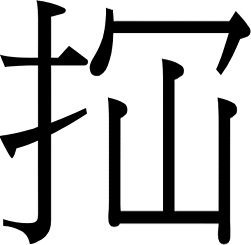What is Hong Kong Supplementary Character Set (HKSCS)?
The Government Common Character Set
 In 1995, to facilitate electronic communication among government departments, the Hong Kong Government developed a Chinese character set that contained locally specific characters required for use on computers by government departments. This character set was called the Government Common Character Set (GCCS) and supplemented the Big-5 character set. Initially, the GCCS was for internal use by the Government. Later, to facilitate the public to access electronic information published by the Government, the GCCS was placed in government web sites for the public to download.
In 1995, to facilitate electronic communication among government departments, the Hong Kong Government developed a Chinese character set that contained locally specific characters required for use on computers by government departments. This character set was called the Government Common Character Set (GCCS) and supplemented the Big-5 character set. Initially, the GCCS was for internal use by the Government. Later, to facilitate the public to access electronic information published by the Government, the GCCS was placed in government web sites for the public to download.
The Hong Kong Supplementary Character Set (HKSCS)
Recognizing the need of the community to have a common set of locally specific Chinese characters, in 1998, the then Information Technology Services Department and the then Official Language Agency worked together to revise the GCCS with a view to extending it to the community. Locally specific Chinese characters were collected from various sectors of the community for inclusion in the GCCS.
In collaboration with the Chinese Language Interface Advisory Committee (CLIAC), the Government of the Hong Kong Special Administrative Region completed the revision of the GCCS in 1999, and renamed it as the Hong Kong Supplementary Character Set (HKSCS). The first version of HKSCS was published in September 1999. The HKSCS-2001 was published in December 2001.
The HKSCS-2001 contains 116 more special Chinese characters as compared with the original HKSCS that was published in 1999. It also technically aligns with the ISO/IEC 10646-2:2001, which was published by the International Organization for Standardization in November 2001.
In May 2005, the HKSCS-2004 was published. The HKSCS-2004 includes 123 more characters than the HKSCS-2001. The HKSCS-2004 technically aligns with the ISO/IEC 10646:2003 that was published in April 2004 and its amendments. The ISO/IEC 10646:2003 and its amendments include all the characters of the HKSCS-2004.
In December 2009, the HKSCS-2008 was published. The HKSCS-2008 includes 68 more characters than the HKSCS-2004. The HKSCS-2008 technically aligns with the ISO/IEC 10646:2003/Amd 1:2005 and ISO/IEC 10646:2003/Amd 6:2009 that was published in November 2005 and in October 2009. The ISO/IEC 10646:2003 and its amendments 1 to 6 include all the characters of the HKSCS-2008.
 In May 2017, the HKSCS-2016 was published. The HKSCS-2016 includes 24 more characters than the HKSCS-2008. The HKSCS-2016 technically aligns with the ISO/IEC 10646:2014/Amd 2 that was published in October 2016.
In May 2017, the HKSCS-2016 was published. The HKSCS-2016 includes 24 more characters than the HKSCS-2008. The HKSCS-2016 technically aligns with the ISO/IEC 10646:2014/Amd 2 that was published in October 2016.
 Download the HKSCS-2016 Document
Download the HKSCS-2016 Document
Number of characters approved since publication of HKSCS-2016: 4
The CLIAC approved the mapping amendment of the HKSCS character "𧃰" (H-8FA8) from the CJK Compatibility Ideographs Supplement code point 2F9B2 to the CJK Unified Ideographs Extension B code point 270F0 at its 25th meeting held on 11 January 2018.
The CLIAC approved the inclusion of the character "岃" (U+5C83, HD-5C83) in the HKSCS at its 26th meeting held on 14 January 2019.
The CLIAC approved the inclusion of the characters "𭉝" (U+2D25D, HD-2D25D) and "𫬷" (U+2BB37, HD-2BB37)in the HKSCS, as well as the glyph change for the character "𢫏" (U+22ACF, H-8ACB) to " " at its 28th meeting held on 3 February 2021.
" at its 28th meeting held on 3 February 2021.
The CLIAC approved the inclusion of the character “㗩” (U+35E9, HD-35E9) in the HKSCS at its 32nd meeting held on 18 February 2025.
After several amendments are published, the Working Group of CLIAC will, subject to the actual needs, recommend that the CLIAC consolidate these amendments and publish a new version of the HKSCS.
The ISO/IEC 10646 is widely adopted by popular operating systems, database software, office automation (OA) suites, web browsers, e-mail clients and input devices. With the HKSCS included in the ISO/IEC 10646, users of popular computer products which adopt the ISO/IEC 10646 will be able to use Chinese characters contained in the HKSCS.
Breakdown of HKSCS-2016 characters
 The HKSCS-2016 contains a total of 5,033 characters, most of which are Chinese characters ( 4,591 characters or 91%). Many of these characters can be found in major dictionaries (including Kangxi Dictionary, Hanyu Dazidian, Hanyu Dacidian and Zhonghua Zihai). Since an individual Chinese character can be used for different purposes, there is no detailed classification of the characters in the HKSCS-2016. Nevertheless, these characters can be broadly classified into the following categories:
The HKSCS-2016 contains a total of 5,033 characters, most of which are Chinese characters ( 4,591 characters or 91%). Many of these characters can be found in major dictionaries (including Kangxi Dictionary, Hanyu Dazidian, Hanyu Dacidian and Zhonghua Zihai). Since an individual Chinese character can be used for different purposes, there is no detailed classification of the characters in the HKSCS-2016. Nevertheless, these characters can be broadly classified into the following categories:
- Proper names, such as names of persons, places or companies
- Characters used in the Cantonese dialect
- Scientific terms
- Radicals and shapes
These characters are mainly proposed by government departments (such as the Companies Registry, the Department of Justice, the Hong Kong Police Force, the Immigration Department, the Inland Revenue Department, the Judiciary, and the Lands Department), academic bodies, educational institutions and members of the public.
The remaining 442 characters are various symbols, such as components of Chinese characters, Hanyu Pinyin symbols, international phonetic alphabets, Japanese Katakana and Hiragana, etc.